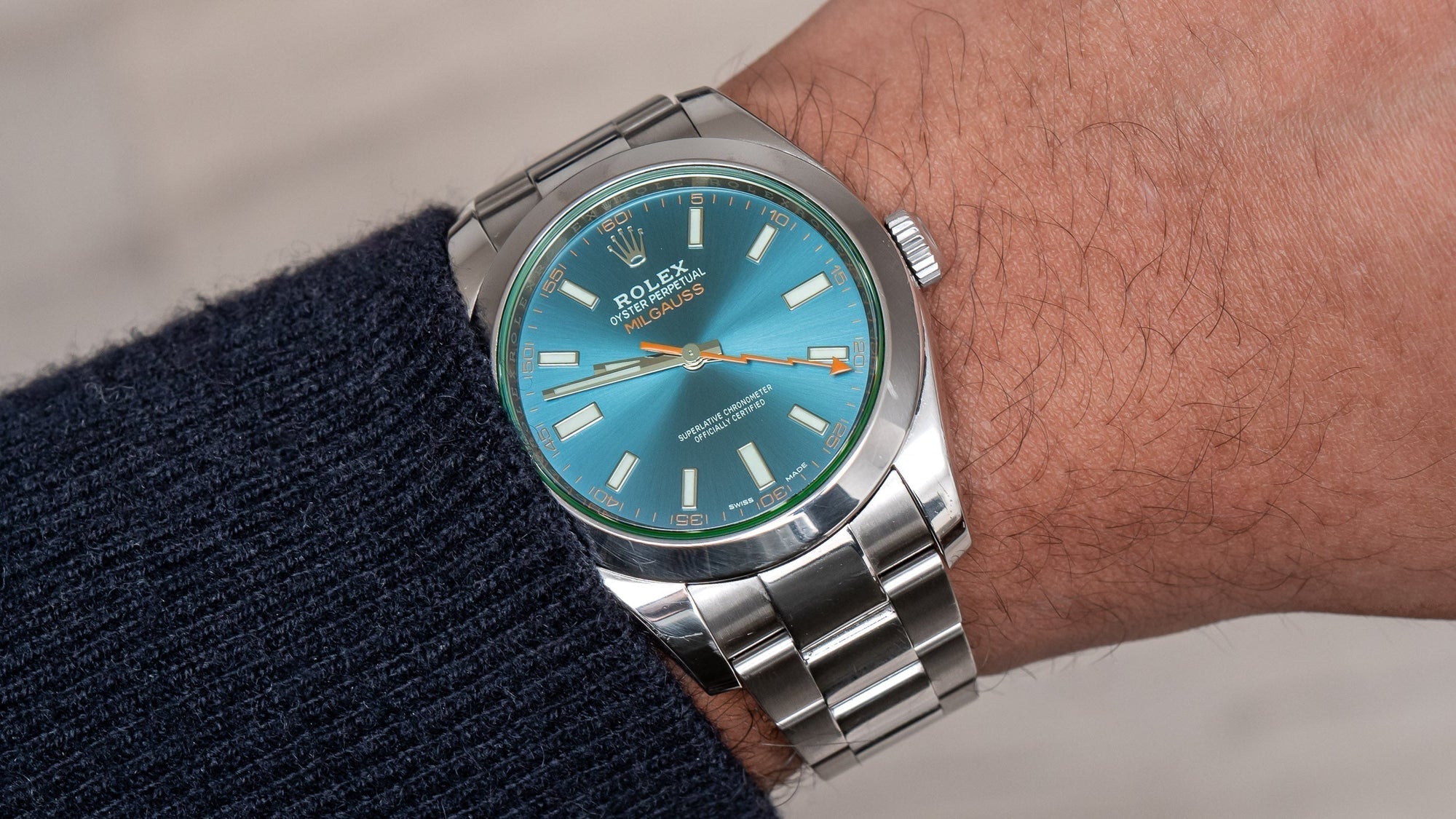All watchmakers with decades or even centuries of history have some designs, lines, or collections that become timeless icons, and others that get lost to history. Here in the 21st century, all of them are subject to various revivals and reissues before being shelved again. Today, we’re going in-depth with a watch that’s recently gotten the axe from Rolex’s contemporary catalog — and one that might be its quirkiest tool watch ever — the Rolex Milgauss. With its easily identifiable lightning-bolt hand and origins as a companion for scientists, the Milgauss has never quite achieved the years-long waitlist fandom that many other staples from the brand have achieved over the years, and back in 2023, the Crown shelved its unconventional tool watch from production.

Maybe it’s an example of always wanting what you can’t easily have, but in recent years, the Milgauss has been attracting a renewed interest at odds with its overlooked reputation. Down below, we’re going to walk through the history of how the Milgauss came to be, explore how the collection has changed over time, and use one model as a case study for its sudden spike in popularity. So, if any of that piques your interest, or if you are already in the cult of Milgauss fandom, keep scrolling, and away we go.
Rolex Milgauss History

As we all are already well aware, Rolex's 120-year historical archive is full of record-breaking, boundary-clearing leaps in mechanical timekeeping. From releasing the first truly waterproof wristwatch in 1926, with the Oyster case; to watches capable of withstanding arctic temperature plummets, with the Explorer; to essentially codifying the DNA of all modern dual-time watches, with the GMT Master — the modern expression of all three of these breakthroughs is still well accounted for in the modern Rolex lineup. But a less-flashy technical achievement the Crown has on its resumé is its innovations in anti-magnetism that really took off in the mid-20th century, and it's this robust development in anti-magnetic technology that is the Milgauss’ bread-and-butter.
The thing about mechanical-movement mechanisms, and why creating and innovating them can be such tricky work, is that the various inner workings all undergo varying degrees of stress when subjected to changes in environment, temperature, and magnetic fields, of course — all of which tamper with the necessary timekeeping accuracy and accountability of each piece collectively. In the early 20th century, magnetic fields weren’t really a daily issue for the regular watch wearer. But with the dramatic advances in military, engineering, and scientific technology through the First and Second World Wars and in their aftermath, suddenly, the tampering of magnetic fields with a watch’s accuracy began to be a very real problem with which to contend.

As the world was entering the atomic age, Rolex needed its own watch that could withstand the demands of magnetically challenging environments. Exposure to magnetic fields as low as 50 gauss in a lab or similar environment could cause the coils of a watch’s hairspring to begin to shorten and stick together, making the oscillator and balance wheel go into hyperdrive, and ultimately making the watches run fast up to hours a day. Far from ideal, especially if you are living in an era before the time on a smartphone was readily available in your pocket, and your watch was meant to be utilitarian.
While other brands, and the Crown itself, had already begun experimenting with improvements in antimagnetism, Rolex saw the opportunity to produce a product that led with intense anti-magnetism as its calling card. In 1956, Rolex unveiled the first Milgauss (ref. 6541), named after the French contraction of “Mille gauss,” translating to 1,000 gauss, which is the international unit of measurement for magnetic field strength. Rolex has always been an adept marketing strategy genius, and immediately this name was interesting enough to be memorable, and also thematically tied in with its functionality as one of the most anti-magnetic watches ever to be created (the IWC Ingenieur released in 1955 with similar inspirations also had 1,000 gauss anti-magnetism).

This feat of anti-magnetism was achieved by a technological one-two punch, combining a soft-iron Faraday cage around the movement, which essentially acted as a forcefield against magnetism, with the Nivarox hairspring Rolex had already used in previous watches, which was comprised of non-magnetic balance components. Effectively ten to twenty times stronger than the typical everyday watch in its resistance to magnetic field tampering, the Milgauss was immediately pitched to the scientific and engineering community for field use. To further tout its anti-magnetic clout, Rolex partnered with CERN (the European Organization for Nuclear Research) to have the Milgauss tested on the wrists of actual nuclear scientists to prove its utilitarian chops and professional credibility.

The Milgauss debuted with a large-for-the-time 38mm case in steel, and featured a honeycombed dial texture and the lightning-bolt seconds hand we still associate with the line today. Perhaps Rolex’s scientist watch was a little too niche from the beginning – after the 6451, the Crown only released one follow-up model, the 1019, which nixed the lightning bolt in favor of a more run-of-the-mill, sports-watch look. The Milgauss line was first shelved in 1988, as scientists embraced less fussy, and inherently anti-magnetic quartz watches (which were undoubtedly more affordable than the Milgauss, too).
In 2007, the Milgauss was selected from the vintage archive to get the revival treatment, and Rolex released the 116400 in a trio of two standard models, along with one special anniversary edition with a black dial and Glace Verte (green glass) crystal. In 2014, the Crown released a new take on the Glace Verte, this time, with a vivid, blue dial. Despite its contemporary comeback, the Milgauss never really garnered mass, mainstream popularity. In 2023, the Milgauss was officially shelved for the second time and is now relegated to the brand’s archive of designs past. A fun fact is that the green crystal is so costly and intensive to produce that Rolex didn't even bother to patent it.
Rolex Milgauss 116400GV Case and Wear

I’ve already alluded to it above, but here in this article, we’ll be diving into what I think is the most compelling modern iteration of the Milgauss: the special anniversary edition reference 116400GV. What makes this model so special, you ask? The green-tinted “Glace Verte” sapphire crystal, of course.
Like many modern revivals, for the 21st-century take on the Milgauss, Rolex did bump up the case sizing here a touch from the 38mm proportions of the original Milgauss. Effectively, the 40mm Oystersteel case, which is, of course, the Oyster case with monobloc middle case construction, is right in contemporary Goldilocks territory — not too small, not too big, and pretty much guaranteed to look great on most wrists. The caseback is closed, and features the necessary suite of engravings around the perimeter (like “Milgauss” just in case you flip the watch over and completely forget what it is). Additionally, we’ve got a screw-down, Twinlock crown, which ensures 100 meters of water resistance and is stamped with the crown logo.

This Milgauss, like all other modern production models, is paired with a matching Oyster bracelet. You might have already been able to tell from its easily-identifiable three-link construction, with polished middle links and satin-finished outer links with polished sides. In typical Oyster bracelet fashion, you have the convenience and ease of the Oysterclasp with its Easylink extension system, which allows you to switch up the length by 5mm without touching any tools.
Glace Verte Crystal And Z Blue Dial

In addition to the Glace Verte crystal, there’s another unique-to-this-model detail that has made it one of the most coveted modern takes on the Milgauss — that vivid blue dial. The immediately eye-catching, electric shade of blue is made even more dramatic with the help of the green-tinted crystal, and makes for a high-contrast, highly legible reading experience. This specific shade of blue, which is often referred to as “Z Blue” by collectors after the internal Rolex color code, is completely unique to the Milgauss, and another reason this iteration in particular is so beloved.
While other modern Milgauss references have experimented with adding a splash of orange on specific hour markers, this model pairs the vivid dial with more tame, cream lume-filled rectangular indices. But that’s not to say that this model is lacking in any pizazz and personality. The orange is tied in with the signature lightning bolt seconds hand (the best detail, in my opinion), the Milgauss logo at 12 o'clock, and the printed numeral track around the dial’s perimeter.
Rolex Milgauss Movement

In the movement department of the Milgauss Ref. 116400GV, we’ve got all the modern caliber technical fineness we could want, but also all the rugged magnetism resistance that makes a Milgauss, well, a Milgauss. The self-winding Caliber 3131 runs the show here, and we still have the protective force field of the integrated Faraday cage system. We have moved on from the Nivarox to the modern Parachrom hairspring, which is inherently anti-magnetic and made from Niobium-zirconium. Technically, this makes the Faraday cage not completely necessary, but it is an extra vote of confidence. Additionally, the Caliber 3131 is a Superlative-Certified Chronometer, meaning that we have assured accuracy of just +/- 2 seconds per day, and the power reserve is a reasonable, but not astounding, 42 hours.
Final Thoughts

So, maybe the Milgauss wasn’t the runaway revival hit that Rolex perhaps wanted, but ultimately, that only makes it more charming, in my opinion. Where the Daytona is the unapproachable, coolest kid in school that everyone wants to imitate, the Milgauss is your unproblematic classmate at the back of science class, ready to help you out when you’re stumped on a complex chemistry assignment. Maybe my personification is going too far here, but I think the Milgauss needs to be taken for what it is – a hardworking cult-classic. I guess we will have to wait and see if Rolex will revive it again for a second time around. You can learn more at rolex.com.



















































1 Comment
As odd as it sounds, this is my grail watch. But I will have to restrict myself to staring longingly at Chrono24 and similar sites since even if Rolex updates it, I have no stomach for playing the “are you good enough to buy this watch” games with AD.